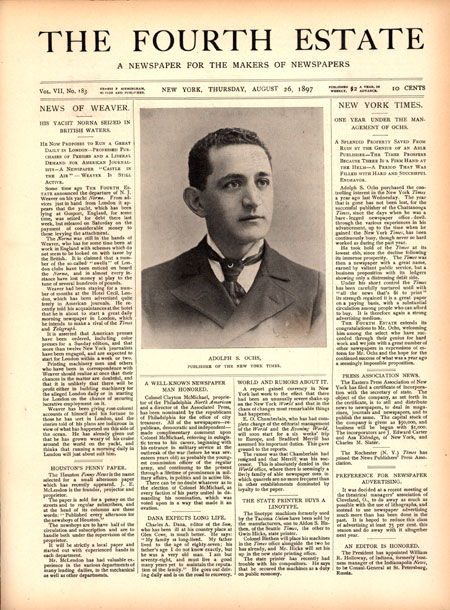By Christopher B. Daly.
The New York Times has a very uncharacteristic Op-Ed column today by lexicographer Jesse Sheidlower arguing that the Times should get in step with the rest of society and start printing a word we all know that begins with “f” and ends with “uck” (and it’s not firetruck!).
O tempora, o mores!
When Adolph Ochs bought the New York Times in 1896, he had high aims. The patriarch of the family that still owns the newspaper — and still sets its editorial direction — wanted above all else to appeal to an
elite audience. His business model was predicated on the idea that he could survive in the crowded New York City market with a smaller audience than the vast audience of workers, tradesmen, and immigrants that Pulitzer and Hearst were catering to, provided that the Times’s readers were wealthier, which would make them more attractive to advertisers. So, he set out to distinguish his paper from the popular “yellow press” papers of Hearst and Pulitzer, which dripped gore and sex. They were read by chambermaids and stevedores, and Ochs wanted no part of them. He was aiming for the upper classes, and he presumed that they preferred a more-decorous approach.
So, in addition to his famous motto “All the News That’s Fit to Print,” he also spelled out his credo in a statement to his readers. He promised that the Timeswould not “soil the breakfast cloth” — meaning that families could bring his paper to the breakfast table (which would have a table cloth, because Timesreaders could afford them) and not have to worry that it would besmirch the conversation or corrupt the children. In fact, Ochs declared his intention that the Times would deliver the news “in language that is parliamentary in good society.”
Thus, it would appear that proper language is part of the paper’s DNA, and the Times has certainly been culturally conservative in the sense that it has been reluctant to depart from the late-Victorian standards of propriety and vulgarity laid down by the current publisher’s great-grandfather.
Of course, it is a fair question to ask how many families gather around the breakfast table sharing the print edition of the Times and how many families are succeeding in preventing their children from learning the f-word.
Pretty fucking few, I’d bet.



